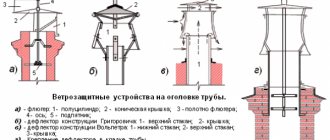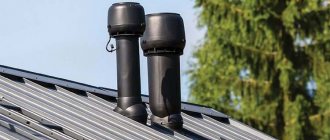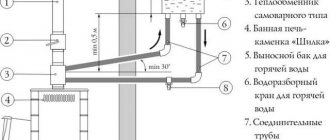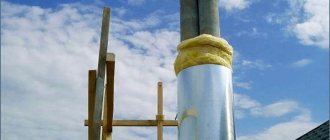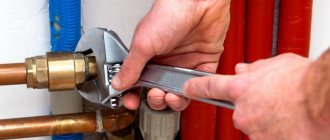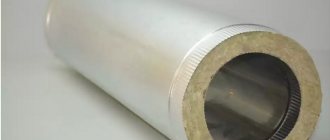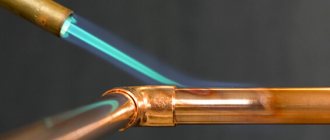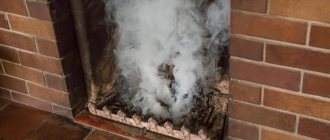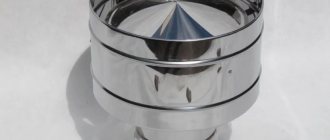Why insulate the chimney? It would seem that this small structure does not require maintenance at all, except for systematic cleaning.
There are several reasons for thermal insulation:
- in summer the chimney can perform its functions without any problems, but with the onset of the first serious cold weather the situation changes: the chimney protrudes above the building and is constantly exposed to wind and moisture;
- Temperature changes, regardless of the season, will sooner or later begin to destroy materials: first, cracks will appear, then entire pieces of plaster will begin to fall off. Therefore, you should immediately think about how to insulate the chimney pipe.
Why were they popular in the past?
During Soviet times, there was an acute shortage of all types of building materials.
Asbestos pipes were a real boon for private developers. The purlins met all safety standards, had no worthy alternative, and were distinguished by their strength, tightness and affordable price. The links were used in furnace making, arrangement of water supply systems, sewerage systems and construction of wells. Over time, GOST requirements were replaced by TU. Changes were made to the production technology, which negatively affected the quality characteristics of the products.
They can only be used for a gas boiler, installed in the middle and end of the chimneys of saunas and baths. But, it is better to abandon this idea and use pipes made according to specifications for arranging low-pressure communications and protective structures for laying cables.
How to properly insulate a chimney pipe with your own hands and why do it?
Good day, dear reader! All prudent homeowners take timely care of the insulation of window and door fillings, balconies and walls of their homes. This allows them to reduce heat loss and save heating costs
But it is equally important to take care of the thermal insulation of the smoke exhaust duct in order to prevent its rapid destruction and reduce the fuel consumption of the heating device. Let's take a closer look at how to insulate a chimney pipe with your own hands.
Why do you need to insulate a chimney?
When fuel burns, heated smoke and moisture are formed, which are transported through the smoke exhaust duct to the street. If the walls of the pipe are exposed to cold from the outside, some of the moisture condenses onto their inner surface. Condensate penetrates into microcracks in the brickwork, where, as the temperature drops, it crystallizes, increasing in volume. The resulting ice crystals press from the inside on the brick and mortar in the joints and destroy them.
In terms of its chemical composition, condensate is not just water, but a chemically active solution formed by the interaction of moisture and fuel decomposition products. Possessing high acidity, such a liquid is capable of corroding the walls of steel chimneys in a fairly short time.
Thermal insulation of chimney walls using modern insulating building materials significantly reduces the risk of destruction of brickwork and reduces the rate of corrosion of metal chimneys.
Advantages of an insulated chimney
External insulation of the chimney duct is an effective way to protect against the harmful effects of condensation, precipitation and wind. Of course, it is not possible to completely eliminate all risks with the help of thermal insulation, but it is quite capable of extending the life of the structure. This happens due to the following factors:
- reducing the amount of deposits on the canal walls, saturated with aggressive substances. Chemically active elements included in the fuel combustion products will fly out into the chimney along with the smoke stream,
- reducing the temperature difference between hot steam and the surface of the chimney walls, cooled from the outside by cold air, which causes condensation to form,
- reducing energy losses. During operation, an insulated pipe takes less energy generated by fuel combustion, so it will be possible to maintain a constant temperature in the room with less wood or coal consumption,
- increasing strength and stability. The thermal insulation system installed around the chimney serves as an additional frame, which increases the strength and resistance of the structure to wind loads.
How to insulate a chimney inside and outside
To insulate a chimney, you should choose a building material that can safely contact high temperatures, is non-toxic, and resistant to fungal attack. Such insulation can be produced in sheet or roll form, in the form of bulk materials, stitched mats or slabs.
Thermal insulation cylinder
Thermal insulation cylinder is used to insulate metal chimneys. It consists of two pipes, one of which has a smaller diameter, and is directly the chimney pipe.
For its manufacture, they mainly use high-quality stainless steel, which is resistant to acids formed on the internal surfaces of the smoke exhaust duct. For lining, pipes with a larger diameter (6 - 10 cm) are used. It is a protective casing. The space between these products is filled with loose basalt insulation.
You can make such structures yourself or buy ready-made “sandwiches” for the chimney at a hardware store.
Mineral wool
Mineral wool is the most suitable material for thermal insulation of stove and fireplace pipes. It is characterized by significant resistance to high temperatures and the effects of chemically active substances, and can be used for both external and internal insulation of smoke ducts.
Currently, 4 types of mineral wool are produced, differing in the type of raw material, fiber structure, length and thickness of the fiber:
- fiberglass,
- stone,
- basalt,
- slag.
Differences in structure determine the properties of mineral insulation. For comparison, the main technical parameters are summarized in the table:
How to properly insulate a chimney pipe with your own hands and why do it?
Why do you need to insulate a chimney, the advantages of an insulated chimney. How to insulate a chimney outside and inside, comparison of technical parameters of materials and do-it-yourself insulation installation for metal, asbestos and other types of pipes.
Choice of insulation
It is immediately important to divide the insulation into 2 groups:
- Independent - which does not require additional protection and steam and waterproofing. These include cylinders for insulation (shells).
- In need of protection – protection from the external environment is required. These include basalt wool for chimneys, EPS and the like.
Before making a choice, it is important to consider several factors:
- What is the temperature of the outlet gases? The higher, the less the pipe needs insulation, but the material must also be heat-resistant and fire-resistant. Accordingly, a thinner layer of thermal insulation can be used.
- The chimney is located inside or outside. If the entire pipe runs along the outer wall of the house, it needs especially high-quality insulation. It takes longer to warm up, which means more moisture condenses during this time.
- What is the chimney made of? If the pipe is metal, it can be insulated using heat-insulating cylinders. Brick - with basalt wool or even EPS.
So, these were the general rules that help you choose how to insulate your chimney. Now let's move on to a direct examination of each of the main materials for insulation.
Advice. Before carrying out work, make sure that all sections of the chimney are securely connected, especially if it is made of metal. Thermal insulation material is not able to prevent the fire of wooden roof elements
Thermal insulation cylinder
Let's start with this material, which closes the question of how to insulate a metal chimney. It consists of 2 pipes, one of which is of a smaller diameter and plays the role of a chimney itself. Usually it is better to take it from high-quality stainless steel with special additives that make it resistant to aggressive acids that form in the chimney. The outer pipe is larger in diameter, at least 6 cm. It plays the role of a protective casing. Basalt insulation is placed in the distance between these pipes. The result is a “sandwich” that is light in weight and size.
You can make such “sandwiches” yourself, or you can purchase ready-made shells for insulating chimneys.
When making such a heat insulator with your own hands, you should take into account several requirements before insulating a metal or asbestos chimney pipe:
- The thickness of the insulation layer for a stainless steel pipe should not exceed 10 cm.
- If the temperature of the outlet gases is high in the pipeline, loose basalt wool should be used. This is a non-flammable material. It does not contain binders, and the combustion temperature rises to 900 degrees.
ATTENTION It is strictly prohibited to use asbestos pipes for high-temperature heaters. Soot accumulates well in such a pipe due to the rough inner walls. At high temperatures, soot can ignite and create excess pressure in the pipe. In rare cases, an explosion may occur inside the pipe.
If we talk about insulating an asbestos pipe, it is practically no different from a metal one. It needs more thermal insulation due to the fact that it absorbs moisture better than metal.
Some people make the following mistake. Most often, when you need to create a temporary chimney. Purchase insulation for chimneys, for example, basalt wool in rolls or mats. The chimney pipe is wrapped with an overlap and the insulation is fixed with metal tape or even ordinary tape. You can't do that!
Any mineral wool must be protected from water and wind. If you leave it open, after a while part of it will be blown away by the wind, and part will be crushed under the influence of precipitation. If you want to insulate, be sure to provide a protective casing. For example, make it yourself from ordinary galvanized iron. In this case, mineral wool, as insulation for a chimney, will last quite a long time.
Mineral wool
By mineral wool we mean basalt (stone) wool, because... it has higher fire resistance ratings. Therefore, it is recommended to use it for insulating chimneys with high temperature exhaust gases.
It can be used both when insulating a chimney inside the attic and outside. If we talk about the attic space, then the chimney can simply be covered with cotton wool mats and secured with metal strips or a rope. Because There is no intense air movement and excessive moisture in the attic; basalt wool does not need protection from the outside. If we are talking about insulating the chimney from the outside of the building, then the approach is completely different.
When insulating with mineral wool, you should opt for high-density stone wool. Typically, the insulation area is small, so you won’t be able to save much on your purchase. It is better to take high-quality thermal insulation for chimneys from a well-known manufacturer, such as Rokwool, Ursa or others presented in your region.
How and with what to insulate other structures?
The most difficult work will be faced by the owners of a brick chimney; metal may not require additional manipulations at all. But in any case, the main requirement for insulation is its non-flammability.
Thermal insulation for brick structures
There are two options. It is possible to insulate with mineral wool (or cotton wool varieties) or plaster, but in the latter case the work will take more time and require effort from the master.
Using cotton wool
The simplest option is to fix mineral wool (glass wool, basalt) with tape. After wrapping, the insulation is “hidden” under cinder concrete or asbestos-cement slabs. Or they leave it open altogether. This is not the best option, even for an attic.
Application of plaster
All work consists of several stages, very extended in time.
- First, a reinforcing mesh is fixed on the walls of the chimney with dowels, then a solution consisting of fine slag, cement and lime is thrown onto it. The maximum layer thickness is 30 mm. Cover all surfaces at once.
- Mineral wool is attached to the slightly dried solution, then the solution is again poured, which is pressed in with a fiberglass reinforcing mesh. Then wait for the layer of plaster to dry completely.
- After the solution has set, the surfaces are leveled, this time the layer of solution is made thinner. Dried walls are treated with a primer: at least twice with a break to dry the composition.
The last stage is painting the chimney. Often, facing bricks, stone, artificial or natural, decorative plaster or porcelain tiles are used to decorate chimneys.
Insulation of metal pipes
Many iron structures do not require additional manipulations, because there are products on sale that can be called semi-finished products. They consist of two pipes, with thermal insulation material already laid between them.
If such a design is not available, then such a product is not too difficult to create yourself. To implement the plan, they buy a pipe that is 60-80 mm larger than the diameter of the chimney. It is put on the canal, then fixed to the base. The space between the elements is filled with light bulk or fibrous insulation.
An alternative is to use the same mineral wool as a sandwich filling. If the roofing system is reliable enough to withstand the additional load, then heavy “filling” can be used as a heat insulator: for example, screened slag or broken brick.
Required materials and tools
The materials required for insulation are listed in the examples discussed.
Tools required to perform insulation:
- plumbing tools (hammer, clamps, pliers, screwdrivers, etc.);
- measuring instrument (tape measure, ruler, square, level, construction pencil, felt-tip pen);
- mounting knife for cutting insulation;
- a riveter and a set of rivets for connecting a galvanized casing (or self-tapping screws);
- electric drill and portable cable extension 220 V;
- drills with a diameter of 4 mm for making holes for rivets;
- for work on applying cement mortar you will need a spatula, trowel and a container for mixing the mortar;
- You may need a construction syringe with a tube of bitumen mastic to seal small cracks. But mastic may also be needed for additional waterproofing of the plaster.
Bitumen mastic can be diluted with gasoline if it has hardened. In this case, the amount of gasoline is determined by eye. Add a little to the mastic and stir until it has a sticky consistency.
We should not forget that any method of insulating a chimney is work at height.
Assess the workplace taking into account all possible risks. Try to minimize them. Prepare the ladder in advance, check its condition, reliability and stability. If you have to move on a roof with slate flooring, walk on the laid boards, this way the weight is better distributed over the area. The board should be laid across the slate waves. Check the integrity of the ropes used to lift materials and tools. If possible, secure yourself with a rope, wrapping it around your waist and securely fastening it to the supporting element of the structure. (In ideal conditions, this is the use of a mounting safety belt). Work in special clothing.
Our next material provides more detailed instructions for building a brick chimney: https://aqua-rmnt.com/otoplenie/dyimohod-iz-kirpicha-svoimi-rukami.html. Here you will learn how to make the correct calculations, what preparatory work is required and much more.
General conditions for passing through a wall
In fact, the arrangement of a passage through a wall or through a roof can be done at the design stage. That is, the designer has every opportunity to include in the documentation the junction of the chimney through the wall. At the same time, he must and will be guided by the requirements of GOST, SNiP and SP for fire safety. Thus, the homeowner can be confident that this unit will be completely safe.
When crossing a wall, it is necessary to take into account that there should be no engineering structures near the pipe that are unprotected from heat. The minimum distance to them should be about 400 mm. If it is not possible to ensure this distance, then measures must be taken to additionally insulate the pipe.
The diagram illustrates how to pass a sandwich pipe through a wall
Passage through the wall of a log structure
Before laying a chimney through a wall made of logs or timber, it is necessary to prepare a hole. If the building is just being built, then, directly when assembling the crowns of the log house, using a gas or electric saw, cut a piece of log or timber in the laid crown. Its size must exceed the diameter of the chimney.
If you decide to go through the wall using a round hole, then before you start making it, it makes sense to drill a center hole; its presence will allow you to drill using core drills or “ballerina drills”.
Note: When arranging a junction through the wall of a frame-panel house, it makes sense to perform preliminary drilling and then mark it. The hole can be made using a ballerina or an electric jigsaw.
Passage through the wall of a building made of logs is carried out in the following ways:
- you can use a telescopic unit, that is, several pipes made of heat-insulating material and with a diameter exceeding the chimney. In this case, the pipes must be inserted into each other;
- the chimney can be routed through the wall, without the use of additional pipes, but the space between the walls and it must be lined with thermal insulation materials, such as basalt wool.
Passage through a brick wall
For arranging a passage through a wall built of brick or blocks with different fillers. Before carrying out its penetration, it is necessary to carry out markings. For these purposes, it is advisable to use a laser measuring tool. In this case, errors will be minimized. When making a hole, you must remember that such deformation of the load-bearing wall can lead to the appearance of cracks. Therefore, builders must take measures to prevent their formation, for example, install a pre-prepared frame in it, which will prevent the wall structure from sagging.
- The installation itself is carried out in several operations:
- a pipe must be installed at the outlet of the boiler;
- install a tee with a valve built into it;
- After installing the tee, pass a sandwich pipe through a pre-prepared hole and connect it to the tee.
The space around the pipe must be filled with fireproof material. It is necessary to install shields at the entrance and exit of the pipe to cover the transition. This shield can be made in several modifications, for example, it can be made of an asbestos sheet and a sheet of stainless or galvanized steel attached to it on top.
Subsequently, the chimney can be assembled like a children's construction set. After the wall has been passed, work begins on attaching the chimney to the wall.
The homeowner, when installing a chimney from sandwich pipes with his own hands, must understand that assembling a gas exhaust system is a very responsible undertaking and the safety of the building structure and the residents living in it largely depends on it.
Which insulation to choose for a chimney?
How exactly to isolate the channel is an important question. There are several types of thermal insulation materials, and each has its own pros and cons. The most important rule: you need to use heat-resistant, non-combustible materials.
Materials used for insulation of chimneys:
- Mineral wool (basalt, glass wool). It is used both in rolls (which are wrapped around a pipe and can be used with both rectangular and round channels) and in the form of cylinders (shells that are used only with round channels).
- Broken brick. This material is used infrequently, is not very convenient to use, and is not very effective (compared to mineral wool).
- Plaster. Suitable for brick chimneys. In terms of complexity of application, the option is relatively convenient, but you will have to wait until the layer of plaster dries. In terms of efficiency, it is inferior to mineral wool.
Destruction of an uninsulated chimney
Both for self-insulation and in the work of professional companies, mineral wool insulation materials are most often used .
How to insulate a chimney with your own hands?
Chimneys of houses have different designs and are made of different materials. The most common: brickwork, asbestos-cement slabs, metal tubular chimneys. Each design has specific properties and requires an individual approach during installation.
Brick chimney
Do-it-yourself insulation of a brick chimney can be done in several ways.
- The first method is plaster. A steel reinforcing mesh is fixed to the outside of the brick masonry chimney. A layer of plaster mortar 30 mm thick is applied on top of it. The solution is a mixture of lime and slag with the addition of a small amount of cement. After the first layer has dried, apply a second layer of the same solution, and then another 2-3 layers. The last coating is carefully rubbed down, puttied, and after complete drying it is painted or whitened with lime.
- Another method involves the use of mineral insulation. A basalt sheet is attached to the pipe on all sides (you can use tape for fastening). Outside, a cladding made of asbestos-cement slabs with a thickness of more than 40 mm is installed on the cotton wool covering. Instead of such slabs, you can build another brickwork. A leveling layer of plaster is applied on top of the cladding.
The main advantages of such a complex design:
- heat losses are reduced by 2 times;
- the likelihood of condensation accumulation is significantly reduced;
- the strength and durability of the structure significantly increases.
Asbestos cement chimney
If the chimney pipe is made of asbestos cement, then insulation is carried out in the following order:
- The insulation design with a metal casing, which is made of galvanized steel, is used. In the case where the chimney is long, the casing is mounted from several sections in the form of a cylindrical pipe no more than 1.5 m long (the sections are placed on top of each other with an overlap of up to 10 cm).
- The gap between the chimney and the casing must be more than 60 mm. It is filled with mineral wool gradually with careful compaction.
- After the gap is completely filled, the top of the structure is filled with thick concrete mortar.
A simplified design can be used. 3 layers of mineral basalt wool are wound around the pipe, then polymer film and foil are applied. Strengthening the structure is provided by metal brackets, which are attached on top of the foil layer.
Steel chimney
Steel chimneys are used, which are made from stainless pipes of the required diameter. The insulation of such a chimney is done using another larger stainless steel pipe. The internal diameter of the outer casing must exceed the outer circumference of the chimney by at least 10 cm. The gap between the pipes is filled with thermal insulation material - preferably basalt wool. Filling is done gradually, in parts, with sufficient compaction.
Modern steel chimneys are made in the form of sandwich structures, i.e. in finished form they have a layered system with thermal insulation. This chimney pipe does not require the installation of additional insulation and is reliable in operation.
Insulating a chimney in the attic
The need to insulate the chimney in the attic is determined by the type of room: cold or heated in winter. If the temperature here is the same as outside, then you need to install insulation on the pipe.
To insulate a pipe in a cold attic, you can use any of the considered structures, taking into account that the likelihood of direct exposure to precipitation is excluded. Therefore, it is recommended to insulate using wooden panels, and the outer side of the frame should be aesthetically treated.
Heated attics are characterized by this design - a frame made of wooden boards or chipboard with a thickness of at least 18 mm, the gap between the chimney and the pipe is at least 50 mm. It is recommended to use basalt wool or felt as a filler.
When making chimney insulation with your own hands, you will need the following standard tool:
When planning private construction, people do not think about the special role of chimneys and the need for their insulation. In fact, insulation is an important element that allows you to increase the durability of the entire stove system.
Working with bricks
Brick as a building material is still unrivaled: in brick houses, chimneys are also made of brick. Insulation of a brick chimney can be done in different ways.
Method one
The first method is plastering, which is easy to do with your own hands. A solution of lime and slag is prepared - it is applied to the outside of the brickwork in a layer of 3-4 cm. A layer of plaster will reduce heat loss by 25%. But in order for the plaster to hold up well under the influence of cold and moisture, it should be applied to a mesh.
The sequence of work can be described as follows:
- a reinforced mesh is attached to the brick surface;
- a slag-lime solution is prepared;
- 3-5 layers of plaster are applied to the mesh: the first layer is the most liquid, the subsequent ones are thicker.
Method two
A more effective material for a brick structure is chimney slab insulation.
The sequence is as follows:
- the brick pipe is covered with insulation boards (basalt or mineral wool mats);
- the insulation is lined with asbestos-cement slabs or brickwork;
- the structure is plastered.
This method is more complicated, but the efficiency of this design allows you to retain up to 50% of heat.
Why do you need to insulate a chimney?
During operation, a large amount of combustion products and hot air is transported through the smoke channel. All this reduces the service life of the chimney due to the acceleration of corrosion processes and oxidation of the internal walls of the outlet channel.
Among the most common problems that lead to damage to the chimney are:
- presence of moisture - increased pressure and constant humidity are observed in the chimney pipe. Due to the temperature difference inside and outside the chimney, moisture partially condenses on the walls of the duct, which ultimately has a detrimental effect on the operational condition of the metal;
- chemical environment - the combustion of solid or liquid fuel produces a large amount of aggressive substances that are hazardous to human health. When the chimney operates correctly, all formed substances are removed outside under the influence of natural draft. When the draft level decreases or when the chimney is not functioning, substances accumulate on the walls of the smoke channel, which leads to slow but progressive destruction of the chimney pipe.
Insulating the chimney using modern thermal insulation materials reduces the risk of damage and reduces the rate of corrosion processes. For example, insulating steel chimneys extends the service life of the product by 2 or more times.
Advantages of an insulated chimney
Timely thermal insulation of the chimney reduces the risk of exposure to factors leading to damage in metal, brick or ceramics. With the correct thickness of insulation, the problem with condensation is solved almost completely - the dew point moves to a section of the pipe located above the roof level. This significantly increases the resource of the smoke duct and the service life of the smoke duct system as a whole.
Insulating the chimney increases its service life several times
Other advantages of an insulated chimney include:
- Reducing the level of deposits - thermal insulation materials help reduce the temperature difference between combustion products and the surface of the chimney. This reduces the amount of substances deposited on the inner surface of the chimney.
- Energy saving - during operation, an insulated chimney takes in less energy obtained from burning fuel. This allows you to reduce fuel consumption and energy spent on maintaining a constant temperature in the combustion chamber.
- Strength and stability - Thermal insulation installed around the chimney acts as a frame and increases the strength and stability of the structure. This is especially noticeable when installing thin-walled metal chimneys.
Modern insulation materials increase the frost resistance of the smoke exhaust system. If the insulation technology is followed, it is possible to reduce or completely eliminate the impact of high temperature in the area where the pipe exits through the roof.
Types of exhaust gas chimneys
All gas chimneys, depending on the material of manufacture, can be divided into several types; these rarely include brick structures, which are practically not used for the removal of heated gases.
A square chimney brick with a round internal cross-section is often used for piping the exhaust pipe.
Made of stainless steel
Metal chimneys are very popular in systems for removing combustion products; stainless steel, which is used more often than others, has the greatest corrosion resistance. Its physical characteristics have the following positive qualities:
- Corrosion resistance to precipitation and condensed moisture significantly increases its service life.
- Stainless steel has good chemical resistance to soot formed after gas combustion.
- Stainless steel is resistant to high temperatures and does not melt up to 500 C.
- Metal chimneys are durable and shock-resistant; if damaged, they can be easily returned to their original shape, a gap or a through hole can be soldered.
- The internal smooth surface does not prevent the escape of flammable gases with soot, its deposition on the walls is minimal.
- The steel outlet casing is light in weight and easy to install, fastening it to the wall with clamps using standard dowel fasteners. The industry produces a wide range of adapters, tees and elbows of standard sizes, making it easy to install a chimney system in any building.
- Installing a steel chimney does not require complex work with significant destruction of walls and ceilings - it can be installed in a built house with a minimum number of dismantling operations.
- The price of stainless steel is quite affordable, its installation is accessible to almost any homeowner.
In the manufacture of metal chimneys, special grades of stainless steel with increased resistance to acids are used.
Rice. 4 Metal chimney
Asbestos
Asbestos-cement pipes contain 85% cement and 15% asbestos; due to the fibrous structure of the asbestos filler, cement is retained in its pores - therefore the product has good strength. The length of asbestos cement pipe products can reach 5 meters, and the cross-section ranges from 100 to 500 mm. To remove smoke, non-pressure products are used, the main characteristics of which are as follows:
- Corrosion resistance to moisture and chemicals, immunity to biological contaminants.
- Long service life.
- Resistance to mechanical loads, except shock.
- The installation is not too complicated without the use of special equipment; the connection is made using special clamps.
- Fire safety, good heat resistance (up to 300 C) and thermal conductivity. When a given temperature is exceeded, asbestos-cement products are prone to rupture and deformation.
- Significant weight, complicating installation work.
- Lower draft compared to metal structures.
- Difficulty or impossibility of installing inspection hatches, inconvenience of cleaning from soot.
- Tendency to accumulate condensation. Asbestos cement, accumulating moisture from the air, emits an unpleasant odor and can transfer it through the walls to adjacent structures.
Rice. 5 Asbestos-cement chimney
Ceramic
When installing a chimney, a ceramic pipeline is sometimes used, the use of which has the following features:
- Pipe elements are made from smooth-walled ceramics - this prevents soot adhesion and allows cleaning no more than twice a year.
- Ceramic products are more convenient to install than their asbestos-cement counterparts. For ease of installation, their surface is equipped with tongues and grooves that provide a strong, sealed connection. When assembling the system, one-piece tees and elbows are used, produced by the manufacturer in a wide range.
- Ceramics are not affected by moisture and do not absorb water.
- The products are resistant to high temperatures and chemical elements that are part of combustion products.
- The high thermal conductivity of the material contributes to its rapid heating - this increases traction and increases the efficiency of the entire system.
- Pipes have high strength and are durable, but like all ceramics, they are destroyed when impacted by hard objects.
- The disadvantages include their high cost (about 40 USD per linear meter); installation of the entire system from high-quality Italian materials can cost about 1000 USD.
- When installed, ceramic chimneys have the most aesthetic appearance - they are usually installed together with insulation in channels made of special chimney bricks, the most expensive types of which have a complex structure of an inner round pipe and an outer square surface.
Rice. 6 Ceramic smoke duct
Coaxial branch system
One of the modern high-tech solutions for the removal of combustion products is the use of a coaxial chimney. Structurally, the device is made in the form of two pipes of different diameters, connected by internal jumpers. The external one serves as a supply of fresh air to the boiler from the outside, while the internal one removes combustion products to the street. The system has the following distinctive features:
- Allows you to maintain oxygen-saturated air inside the room, which is not absorbed by the operating boiler; there is no need to install flow-through ventilation in the house.
- In coaxial types, the problem of condensation is solved - thanks to the special design, it does not accumulate on the internal walls.
- The outlet pipe can be located in any plane and have a short length.
- The device has a high efficiency and is fireproof - the exhaust air is cooled through the pipe walls by the external flow.
Typical mistakes of beginners and self-taught
In first place among the mistakes is the incorrect height of the chimney pipe. An option that is too high creates excess draft, which increases the likelihood of tipping over and drawing smoke back into the firebox and the room with the stove. 5–6 meters are considered optimal, but much here depends on the size of the combustion chamber and the configuration of the chimney.
A constant flow of air into the firebox is a must for good draft in the chimney, which is why it is so important to equip a room with a fireplace or stove with high-quality ventilation
The chimney should not be overcooled or overheated as a result of intensive combustion of fuel in the firebox. Everything must be in moderation, otherwise the pipe may crack. To make it easier for yourself to identify these cracks, you should whitewash the section of the chimney in the attic. All soot “drips” will be visible on a white background.
Often, when installing a steel chimney, beginners forget to ensure condensate drainage. To do this, you need to make a special collection and insert inspection hatches into the pipe. Mistakes are also made in choosing the steel grade.
During normal combustion of wood, gas or coal in a fireplace or heating boiler, the chimney warms up to 500–600 °C. However, the temperature of the smoke, even for a short time, can rise to 1000 ° C. Moreover, just a few meters from the firebox they cool down to 200–300 degrees and do not pose a threat to the pipe.
But its initial meter section from the boiler manages to heat up very strongly. The steel must be heat-resistant and able to withstand these loads. And the insulation of a steel pipe should be done only a couple of meters from the firebox in order to prevent overheating of this segment of the chimney.
To increase fire safety, passages through ceilings and walls are made through special non-flammable inserts; direct contact of hot pipes and flammable building materials is unacceptable
When laying bricks by an inexperienced craftsman, vertical displacement of their rows relative to each other is often allowed. When building walls, this is allowed, but in the case of a chimney, it is absolutely unacceptable. This greatly reduces the efficiency of the chimney duct, as flow turbulence and soot deposits on the walls begin to form in it, which will require cleaning over time. You can read how to do this correctly in this material.
The foundation under a brick chimney must be extremely reliable, otherwise the pipe may be pulled to the side with subsequent partial or complete destruction. And if smoke removal is done for a gas boiler, then it is better to exclude brick. It quickly breaks down under the influence of the alkaline environment formed during the combustion of natural gas.
Why insulate a chimney pipe, what benefits does it give?
- First of all, the device of thermal insulation of pipes allows you to get rid of the dew point, or rather transfer it to the layers of insulation or even further to the outside of the system. In this case, there will be no freezing of the masonry or other material from which the pipe is made.
- In addition, the steam mass will not cool down prematurely, which will reduce the deposition of resins and soot on the walls of chimney structures. Here the economic component is immediately obvious, because you won’t have to often resort to the services of chimney sweeps.
- The available cross-section of an insulated chimney network will always be large, which has a positive effect on the natural circulation of air masses and efficient combustion of the coolant.
- Reducing repair costs is another good reason why you should insulate your chimney. After all, a thermal insulation system assembled once will eliminate a whole string of consequences.
Helpful advice: Insulating chimneys is not difficult; there are many special materials designed for domestic and professional use.
Mineral wool insulation for chimney pipes
The Rockwool company has a large selection of certified basalt insulation, which has proven itself in high-temperature facilities and has proven its effectiveness, as well as high insulating properties.
Mineral fiber made from basalt rocks does not burn, which means it increases the fire safety of a building, which makes it ideal for insulating complex technical objects. In addition, Rockwool basalt insulation can withstand high operating temperatures of 750 degrees and briefly up to 1000 degrees, which is more than enough for energy-intensive facilities.
The practicality of using thermal insulation makes it possible to install thermal protection on objects with complex geometry, for which the manufacturer’s arsenal includes technical insulating mats, slabs, special segments for thermal insulation of pipelines of different diameters, arrangement of junctions and other components.
Why and where is insulation necessary?
No one doubts the fact that any structure will begin to collapse over time. This applies to all structures: chimneys made of brick, metal or asbestos pipes. During the removal of gases, combustion products accumulate on the walls of the pipes. Condensation that forms at the dew point settles in them: where cold masses meet warm currents. High-quality insulation solves several problems at once. It allows:
- strengthen the structure, since the thermal insulation frame is additional protection from temperature changes and gusts of wind;
- reduce the risk of destruction of the walls of the structure due to constant contact with condensing aggressive moisture;
- make the operation of the heat generator more efficient, since thermal insulation means less fuel consumption;
- prevent problems with deterioration of traction: high-quality insulation reduces the thermal conductivity of pipes and prevents intensive accumulation of deposits.
An insulated chimney will look better and last longer, as the wear resistance of the protected materials increases. In addition, the roof located near the structure will also receive additional protection.
Insulation is necessary in the place of the pipe where the warm surface of the chimney “meets” the cold air. As a rule, this area is located either in a cold attic, or where the structure is exposed to the roof.
Why is condensation dangerous?
To better understand why the chimney condenses, just breathe on the window glass. It will instantly become covered with fog, then droplets of steam will begin to merge into a stream. Condensation also forms in the system, then condensate flows down from the chimney. The reason is wood burning in the firebox.
If ideal working conditions are created in a stove or fireplace, that is, when the temperature at the exit from the mouth of the pipe reaches 100-110 degrees, then water vapor will not be able to “catch” on the internal masonry and will calmly come out. But when the temperature on the inner surface is about 40-61 degrees, then condensation will begin to settle and many problems will arise.
Harmful substances will accumulate, dissolve the soot, and then condensation will continue to flow from the chimney. It's still so scary. Then everything will turn into sulfuric acid or some kind of black liquid with a pungent odor. The brickwork will gradually corrode, forming black resinous stains on the walls.
Collecting condensation in the chimney will lead to other problems. The draft in the system will instantly weaken, an unpleasant odor will appear in the room, and the pipe, along with the fireplace and stove, will begin to collapse.
This can be avoided by determining the temperature of the exhaust gases. The method is simple. Take a dry splinter and place it across the opening of the view when the device is heated. After half an hour, remove the splinter and scrape off the sooty surface.
There are many more ways to deal with condensation, for example, if you install a condensate drain for the chimney. But you need to figure out what a chimney is and what type it is.
Installation features
The chimney should be assembled with the sandwich so that the wide part of the inner pipe is directed upward. Professionals call this method “condensate”.
Smoke in this design rises upward, and condensate flows down. The outer pipe is positioned with the wide end downwards (“along the smoke”).
Chimneys are divided into external and internal. Advantages of an attached chimney:
- Ease of maintenance,
- Location outside residential premises;
- There is no need to arrange junctions through the floors.
If you decide to install a chimney inside the house, there are also certain advantages. It will be less exposed to weather conditions and will therefore last longer.
The chimney should be installed from the bottom up, in the direction of the smoke. When connecting, be sure to use a heat-resistant sealant.
The minimum distance from the smoke exhaust system body to ceilings and floor structures is listed in SNIP (see above). It is impossible to violate the requirements, as this may result in a fire in the structure.
Expert advice
Install a smoke exhaust channel according to the rules. It is also worth taking advice from experts. Thermal insulation is carried out according to the following standards:
- thermal insulation must be applied in a continuous layer, without transitions, especially in places of contact with the ceiling and roof;
- mats and strips are laid only with the markings facing outwards;
- installation of parts is carried out from the bottom up, overlapping, the lower end is covered with the upper connection;
- internal insulation is carried out in stages, during installation of the structure, external insulation after complete assembly;
- a spark arrester is installed at the end if the roof consists of flammable materials;
- use personal protective equipment.
The rules are simple; following them will help prolong the operation of the output channel.
Advantages of using galvanized pipes
The main advantage is the presence of the protective layer described above. We found out that when exposed to condensation, any metal begins to rust, and therefore the tightness of the chimney duct and the efficiency of its functioning are impaired. But if you protect the product well from moisture, it will last much longer. Because of this, galvanized chimneys have become increasingly popular in recent years.
Note! High-quality sheet steel is used in production. Before shaping, it is immersed in a zinc solution, where a chemical reaction occurs under the influence of reagents
The protective layer created in this way is quite sufficient to significantly extend the service life.
And chimneys made from this material have the following advantages.
- High heating rate and, as a result, almost instantaneous generation of thrust. This allows heating devices to operate as efficiently as possible.
- Such chimneys include several modules, which, if necessary, are quite simple to assemble.
- The products can be installed on any heating devices. Simply put, another advantage is their versatility.
- All galvanized pipes are fire resistant and therefore fireproof. And this is especially true for wooden houses.
- Installation requires a minimum amount of free space.
- Wide variety of variations.
- High resistance to condensation (especially compared to brick analogues). More effective in this regard are only chimneys made of stainless steel.
- Finally, the smooth surface prevents soot from collecting on the walls, making cleaning quicker and easier.
Note! In light of all of the above, we come to the conclusion that galvanized products are much better than brick ones, and are inferior in quality only to stainless steel pipes. Consequently, their main advantage is considered to be savings (both on purchase and on installation work)
But remember that often saving on the quality of purchased material is fraught with significant costs for maintenance and repair work.
Basic requirements for chimney systems for gas boilers
When installing chimney ducts, to ensure their efficient operation and fire safety, the requirements specified in the regulatory documentation SNiP 2.04.05-91 and DBN V.2.5-20-2001 must be strictly followed. Their main provisions are the following points:
- The chimney cross-section (pipe diameter) should not be less than the boiler outlet pipe.
- The main pipe should be positioned vertically without inclined sections (let's say a slope of no more than 30 degrees), and there should be no curvatures or narrowed sections in its design.
- The maximum number of turns in the branch main is no more than three with the length of side branches up to 1 meter.
- The permissible distance between the walls of the chimney and non-combustible surfaces is at least 5 cm; if it passes through combustible walls and the roof, the permissible distance is more than 25 cm.
- The material used to make the chimney duct must be resistant to high temperatures and have a structure that prevents the passage of gases.
- All connections must be sealed, the insulation must not allow moisture and gases to pass through.
- Where the pipe duct passes through the roof, the structure must be solid and without joints.
Rice. 3 Boiler piping diagram
- At the bottom of the pipe there is usually an element for collecting condensate. The material used to make it must be resistant to moisture and gas combustion products.
- In places where turns are provided, inspection hatches must be located to clean the chimney from contaminants and condensate.
- The length of the chimney duct must provide good draft, the height of its outer part must be at least 50 cm above the roof ridge.
- When installing a smoke exhaust channel, it is necessary to have a protective canopy in its upper part to prevent the ingress of dirt and precipitation.
Wooden shields
The most versatile and simple way of insulation is wood paneling. A wooden frame is made, covered with slate slabs and fastened around the pipe. All free space between the chimney and the panels is filled with insulation: sand, dry earth, glass wool and slag. Of course, although externally insulated, it still needs maintenance: the chimney needs constant cleaning from the inside.
First, the surface is completely cleaned, then the sheathing is made of metal profiles:
- fasten the guides with a step equal to the width of the insulator using dowel-nails;
- the guide lower profile is additionally attached to the roof with self-tapping screws;
- vertical posts are attached to the guides using small self-tapping screws.
Basalt wool is laid without gaps to prevent the appearance of “cold bridges”. The dimensions of the insulation boards may be larger than that required by the sheathing, then it is trimmed using a sharp knife. If the insulation is laid in several layers, then, starting from the second, they are “bandaged”, shifting so that the joints of the plates do not coincide. When working with mineral wool, observe safety precautions.
After installation, the chimney insulation is covered with a vapor barrier film. The joints of the film are glued with special tape. The final stage of thermal insulation work is cladding with plaster or metal siding with a polymer coating.
Features of insulation of chimneys of various shapes
When installing chimneys of square or rectangular shapes, thermal insulation is performed using a frame. Using the same technology, you can also insulate smoke ducts with a round cross-section. For example, to insulate an asbestos chimney consisting of several pipes, the construction of a frame box is required.
Sequence of work on insulating smoke shafts of square or rectangular configuration:
- maintaining an interval of 10 cm from the perimeter of the object being equipped, assemble a frame from metal profiles or a wooden block. Fastening is carried out using galvanized nails and self-tapping screws 30-50 mm long;
- the space between the sheathing and the walls of the gas outlet shaft is filled with mineral insulation;
- the outer perimeter of the frame is sheathed with asbestos panels 10-12 mm thick.
At the final stage, the joining seams are filled with heat-resistant plaster, as is the upper perimeter of the frame, to ensure the tightness of the structure.
